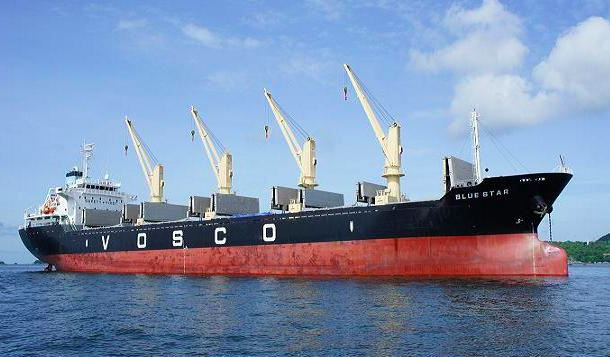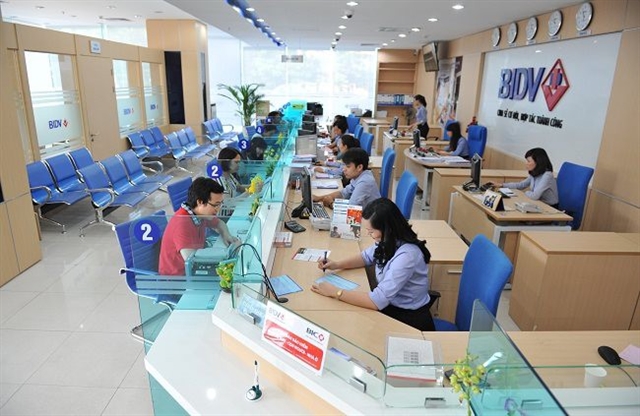 Economy
Economy


|
| Customer's transactions at a BIDV.branch. — Photo vietnambiz.vn |
Compiled by Thiên Lý
Last year State-owned joint stock commercial banks led the banking sector in terms of interest receivables.
Interest receivable refers to interest that has been earned on investments, loans and overdue invoices but has not actually been paid yet. As long as it can be reasonably expected to be paid within a year, interest receivable is generally recorded as a current asset on the balance sheet.
Leading the way was the Joint Stock Commercial Bank for Investment and Development of Việt Nam (BIDV) with interest receivables estimated at VNĐ11.89 trillion (US$517.26 million), up 25.5 per cent from 2017.
The Joint Stock Commercial Bank for Foreign Trade of Việt Nam (Vietcombank)’s interest receivables amounted to VNĐ7.41 trillion ($322.17 million), a 23 per cent increase from the previous year.
In spite of having its interest receivables going down by 52 per cent to VNĐ6.9 trillion ($300 million), the Việt Nam Joint Stock Commercial Bank for Industry and Trade (Vietinbank) still ranked the third in the list.
Several private joint stock banks also registered high growth in the amount of interest receivables like Techcombank, where they grew at 48 per cent, Sacombank (33.2 per cent), and LienVietPostBank (29.7 per cent).
Analysts say interest receivables play an important role in lenders’ business operations but often do not get the attention they deserve.
One consequence is that it sometimes it means growth is only on paper.
The more interest receivables a bank has the more bad debts it is likely to have, they point out.
Thus, banks have to keep a close eye on interest receivables and eliminate irrecoverable debts as soon as possible from their books.
But in reality, many are not ready to do so.
Experts have called on the Ministry of Finance and State Bank of Việt Nam to carefully assess how lenders are accounting for interest receivables in order to take proper measures to make them reflect their actual revenue situation.
The banks should regularly review the interest outstanding they expect to collect in order to weed out irrecoverable debts in a timely manner, they say.
But they admit it is not easy for banks to immediately eliminate irrecoverable debts, and need time and a roadmap to do it because it will have a bearing on their profitability.
Vietinbank is one of only a few banks that have eliminated bad debts. It has in fact written off VNĐ7.5 trillion ($326 million).
This brought down its interest receivables to VNĐ6.9 trillion, equivalent to 0.59 per cent of its total assets, the lowest rate in the entire banking sector.
The bank’s chairman, Lê Đức Thọ, said eliminating irrecoverable debts from interest receivables was imperative to firmly consolidate the bank and make it ready to adopt Basel II standards.
Senior banking expert Dr. Nguyễn Trí Hiếu stressed the need for the central bank to access the interest receivables of each bank basing on their actual financial capability in order to outline proper plans for them to weed out irrecoverable debts.
Việt Nam banks, foreign investors keen on each other
Many analysts say it is time for the Government to increase the foreign ownership cap in banks to 49 per cent from the current 30 per cent to help them meet requirements amid the country’s rapid integration and be able to compete with their international peers.
Their suggestion comes at a time when many banks including state-owned ones are in dire need of capital to implement their restructuring plans and meet Basel II norms by 2020 as required by the State Bank of Việt Nam (SBV).
To realise these goals, the lenders have to consider various options, and one of the most feasible is to seek foreign investment.
Many banks plan to list their shares but have said they will sell stakes to foreign investors before doing so.
A spokesman for Nam A Bank said the lender had been seeking to increase its charter capital from VNĐ3 trillion (US$130.4 million) to VNĐ5 trillion ($217.4 million) since 2018 but without success.
This year it would continue with the efforts and expected to raise part of the new capital from foreign investors by selling stakes, he said.
As for OCB, since its foreign ownership is only 5 per cent and the maximum allowed is 30 percent, there is much opportunity for foreign investors.
A bank spokesperson said it was negotiating with some foreign entities to sell stakes.
The Việt Nam International Joint Stock Commercial Bank (VIB) has 20 per cent foreign ownership and is seeking partners to sell the remaining 10 per cent to increase its charter capital.
Why do banks prefer to sell stakes to foreign investors?
The outstanding success achieved in recent years by some banks which have sold capital to foreign partners has encouraged them.
Last year for instance HDBank, VPBank and Techcombank successfully sold stakes to global players.
HDBank sold more than 21 per cent to no less than 10 foreign investors for $300 million (VNĐ 6.8 trillion) before listing on the HCM Stock Exchange (HoSE).
Techcombank reached the 30 per cent foreign ownership cap by selling shares to Warburg Pincus for $370 million before listing on HoSE.
After Standard Chartered Bank sold its stakes in Asia Commercial Joint Stock Bank (ACB), it sold them quickly to Alp Asia Finance Limited. The company now owns nearly 10 percent and ACB has reached the 30 per cent foreign ownership limit.
The market is waiting for the Commercial Joint Stock Bank for Investment and Development of Việt Nam (BIDV) to sell a stake to South Korea’s KEB Hana, which is expected to be completed this year.
Last year it received approval from shareholders to increase its charter capital by 17.65 percent by issuing shares to KEB Hana, which will own a 15 percent stake following the capital increase.
Analysts said the Government should soon increase the foreign ownership cap from 30 per cent to 49 per cent to create opportunities for lenders to carry out restructuring.
Though the Vietnam Bank for Agriculture and Rural Development (Agribank) has yet to equitise, and expects to complete the process only early next year, many foreign investors have expressed interest in buying stakes in it, including South Korea’s NongHuyp.
Recently Srisawad Corporation of Thailand expressed interest in buying out Agribank’s subsidiary ALCI financial leasing company. VNS